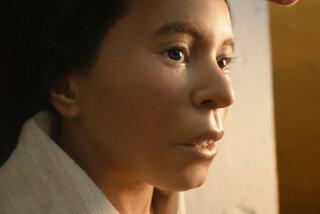Almshouse Puts a Face on Poverty in 19th Century
- Share via
TROY, N.Y. — Inside a technology park across the Hudson River from Albany rest the lifelike facial reconstructions of nine seemingly diverse individuals: black and white, young and old, male and female.
A look into their past, however, reveals a common thread: They lived, worked and died at one of New York’s earliest poorhouses, which housed Albany’s paupers, orphans and mentally ill in the 19th and early 20th centuries.
When the almshouse residents died, they were buried in unmarked graves in a cemetery on the site. For the first time since they were reburied to make way for a $60-million biomedical research laboratory, scientists have re-created the faces of nine people from skeletal remains in hopes that relatives could identify them.
“Part of the idea of this project is to give faces to the poor people of the time,” said project leader Gay Malin, a facial reconstruction specialist with the New York State Museum.
For a century, thousands of outcasts sought refuge at the Albany County Almshouse, on 216 acres a few miles from the state Capitol. The majority were foreign-born, mostly from Ireland and other parts of Europe. Many suffered from dental disease and infections ranging from scurvy to syphilis.
The almshouse was shuttered in 1926 -- 100 years after it opened -- and the last 100 residents were transferred to a nearby nursing home. Historical records showed that about 2,400 people were buried in the almshouse cemetery.
In 2002, developers broke ground on a research center on the site of the cemetery and asked a team of State Museum archeologists to excavate the site. For a year, scientists dug up wooden coffins, exhumed skeletal remains and uncovered personal belongings, including a wedding ring.
Remains of 1,200 individuals were recovered. Of those, 986 could be identified as male, female or juvenile, said Chuck Fisher, a state archeologist who hoped that the reconstructions would prompt relatives to come forward and identify the remains. But he admitted that it would be difficult to match individual remains to the almshouse ledgers since the burials were unmarked.
Before the remains were reburied at the Albany County Rural Cemetery, they were taken to an on-site mobile lab where the bones were cleaned, photographed and analyzed.
Of those excavated, nine skulls were intact enough to sculpt a three-dimensional facial reconstruction. Malin created two replicas of each skull to be included in a future museum exhibit.
One skull was left unadorned so that museum visitors could view the underlying bone structure. The other skull was made to look like a face, an image of what the almshouse resident might have looked like based on his bone structure.
With the skull on a swivel stand, Malin placed tiny tissue markers on the face to determine the depth of the eyes, nose, mouth and cheeks. She then used clay to give shape to the face, which was painted. A hair historian was consulted to dress the mannequins in wigs based on styles of the time.
It took Malin a year to sculpt the skulls in her windowless lab at the Rensselaer Technology Park in Troy. Of the nine, six were males and three females. Five were white and the rest were black.
The oldest was a black male known only as “B318.” His bones showed that he was malnourished as a child, stood 5 feet 2 inches and died in his mid-60s. He was also the only one of the nine to be autopsied upon his death, as evidenced by the hinged skull.
The youngest was a 17-year-old black male with a welt on the right side of his forehead. His bones revealed that he suffered from the tropical infectious disease yaws, which causes strawberry-shaped bumps on the skin that can break open and form ulcers.
Then there’s the bucktoothed white woman with the puckered look. Because she was the only resident to be buried in a cast-iron coffin, her remains were 95% intact. She lived until her early to mid-40s. The left side of her nose is broken, possibly from a violent blow, and she suffered from gallstones and arthritis in the knees.
The faces are a mere snapshot of the thousands of residents who passed through the poorhouse, which opened in 1826. The residents lived in a poorly ventilated, 10-room, two-story brick building -- one of half a dozen structures on the property that also included a farm, hospital and asylum.
More to Read
Sign up for Essential California
The most important California stories and recommendations in your inbox every morning.
You may occasionally receive promotional content from the Los Angeles Times.













